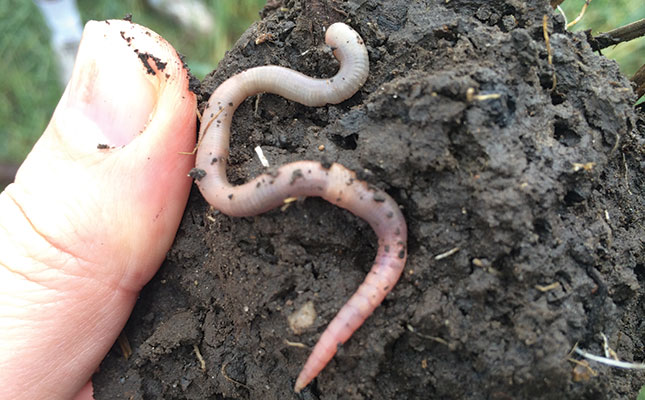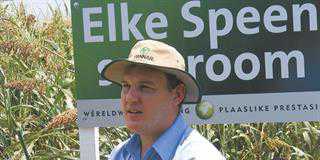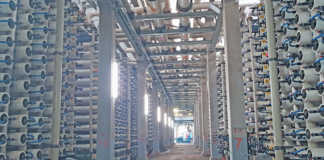
Photo: Hendrik Smith
The greatest threat to South Africa’s farmlands doesn’t come from the global economy or government policies. It’s to be found under a farmer’s feet.
According to Dr Hendrik Smith, conservation agriculture facilitator, 95% of food production is estimated to rely directly or indirectly on soil. Yet this resource has long been taken for granted, and a large percentage of agricultural soils are moderately to highly degraded through years of neglect or misuse.
The good news is that, in many instances, the situation can be reversed by changing production practices and rebuilding the soil. Healthier soils will not only secure food production, even in less-than-ideal situations, but also restore biodiversity and reduce carbon emissions. The potential for carbon sequestration is increased by nurturing soil health and photosynthetic capacity through good soil management.
“If soil health is neglected, less carbon will be stored in the soil. This will have a detrimental effect on the environment and could expedite global climate change,” stresses Smith.
Soil erosion
Soil erosion is a major environmental problem that affects land and water resources in South Africa. Although a natural process, it is accelerated by human activities such as the clearing of vegetation, soil tillage and overgrazing.
READ The role of conservation agriculture in reducing soil erosion
Soil erosion has a multitude of adverse on- and off-site consequences, such as decreased soil fertility, lower water quality, and lower yields. It involves the loss of fertile topsoil and the reduction of soil productivity, but is also associated with sediment delivery to rivers, causing siltation and pollution of water resources.
In humid areas, erosion from water flow is more common, while in arid and semi-arid areas, the main culprit is wind.
Soil management
Conservation and precision agriculture practices can help to sustain current food production. They can be achieved by adopting conservation plans that are practical, site-specific and an integral component of the overall agricultural production system.
Conservation practices should include no-till or reduced tillage that leave post-harvest crop residue to cover the soil surface, and incorporate cover crops, crop rotation and livestock integration, the construction of grassed waterways, terraces and buffer strips, and pasture erosion control systems with manure application and soil testing.
Regenerative conservation agriculture provides a comprehensive approach to soil and crop management, promoting the long-term sustainability of farming systems in terms of profitability and resource management. This farming philosophy focuses on nurturing soil health.
Test the soil
Proper and regular soil analysis is one of the keys that can unlock the door to proper soil management and increased production. The data obtained can be used to adjust soil management and agronomic practices according to specific needs.
Crops are grown in a wide variety of soil types, and fertiliser requirements will therefore depend on soil health and condition. The first step towards achieving healthy crop production should be to bring the soil into balance, and for this, regular soil analysis is needed to ascertain the exact nutrient composition and pH level.
READ Call up your soil microbe army and win the battle for profit!
The wrong application of nutrients can result in an imbalance in the soil and eventually affect the environment and even contaminate the water.
Farmers should also look at the nutrient requirements of each crop. The various crops in a rotation system have different nutrient requirements and may have different critical nutrient levels. Soil testing as well as leaf analysis will determine the crop’s nutrient needs.
In addition, each crop has a distinct nutrient removal rate, and knowing this helps to determine a fertilisation strategy.
By doing simple top- and subsoil analyses, early interventions can be planned and prioritised. It is always better to have a proactive strategy than to be reactive. Unplanned, reactive interventions can lead to money being wasted on unnecessary extra fertilisers or nutrients.
According to Smith, the overapplication of nitrogen fertiliser is largely responsible
for the many cases of rapidly increasing soil acidity on farmland. An increase in soil acidity severely inhibits root and plant growth and reduces the ability of the soil to tolerate irregular rainfall or extended dry spells.
Soil biology has a direct effect on soil structure and chemistry, determining to what extent nutrients are bioavailable. Excessively high levels of certain elements can have a detrimental effect on soil biology.
Cover crops
Although cover crops are not necessarily harvested for a profit, they are beneficial in many other respects. The roots of cover crops create channels in the soil that improve its ability to absorb water. Cover crops also build soil organic matter, help to keep soil in place and prevent it from eroding, and feed soil organisms that provide valuable nutrients to cash crops during the traditional growing season.
According to Smith, the use of cover crops can further increase the crop canopy and ground cover on the soil, while the presence of permanent and strong living root systems greatly enhances soil’s resistance to erosion. Cover crops also allow for the integration of livestock in a sustainable manner, which further facilitates the build-up of soil organic matter.
Ultimately, proper application of conservation agriculture leads to higher organic matter levels in the soil and this can be the key to stabilising production areas against the devastating effects of erosion and climate change.
Organic matter content
Organic matter content is essential to soil’s physical, biological and chemical functions, and is the key factor governing soil health and productivity. This organic matter is made up of plant and animal residue at varying stages of decomposition, and comprises approximately 50% carbon.
It is said that for every 1% increase in organic matter, the soil draws down 10 times more carbon from the atmosphere, and holds an extra 140 000ℓ water/ha.
“Studies have shown that increasing the carbon content of soil not only significantly enhances its resilience to drought and erosion from heavy precipitation, but also enables the soil to retain more water, which is then readily available for plant growth and micro-organisms.
“Compaction is one of the biggest problems faced by farmers, as it can form a major barrier to water and root infiltration. Water needs to work its way into the soil to lower surface water levels, encourage deep rooting and create optimal living conditions deep in the soil. Improved water retention also helps offset drought,” says Smith.
Increase crop biodiversity
Plant or crop diversity helps to break disease cycles and provide a habitat for pollinators and organisms living in the soil.
Ecosystems rich in biodiversity are more resilient and recover faster from stress such as climatic extremes, human impact and land degradation. A healthy agroecosystem boasts a wealth of living creatures, including bacteria, fungi, nematodes, insects and earthworms.
The soil also contains a vast number of living micro-organisms. These help to manage soil structure, plant diseases, insects and pests. They also form beneficial symbiotic associations with plant roots, cycling nutrients and storing carbon.
Crop rotation systems reduce pests and diseases that are specific to certain plant species, build the health of soil microbes that provide nutrients to crop plants, and ultimately lead to improved yield.
Grazing animals on lands helps to recycle nutrients across the landscape. By controlling where the livestock graze, a farmer can add valuable nutrients and organic matter back to the lands and ultimately, the soil.
The role of insects
The beneficial role of insects in agriculture should not be underestimated, and this is particularly true of dung beetles. As these remarkable little recyclers go about their daily business of breaking up and distributing dung, they offer a variety of benefits to nature.
Dung beetles perform a vital ecological function by clearing away the droppings of large animals and returning key nutrients such as phosphate, nitrogen and carbon, thereby increasing soil fertility that fostering plant growth.
Apart from building soil nutrients and fertilising the soil, dung beetles increase the organic matter content of the soil and aerate and mix the soil by burrowing. These changes in the soil improve its water-holding capacity and nutrient availability, both of which benefit plants.
The dung beetles’ activities also distribute plant seeds contained in the dung and keep pest and parasite populations under control, saving the livestock industry millions of rands annually.
“They play a particularly important role on a farm if populations are large enough,:” says Smith. “They offer a self-sustaining solution to reducing methane gases and surface run-off of manure contaminants, and thereby improve water quality, soil health and pasture productivity.”
Email Hendrik Smith at [email protected].











